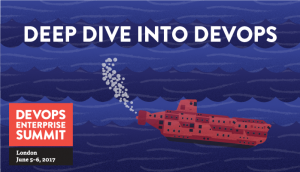The Danger of Denying Reality: DevOps Enterprise Summit London Review
 I was very fortunate to be able to attend the DevOps Enterprise Summit in London recently. The conference is organised by ITRevolution which is lead by DevOps luminary Gene Kim who has written a number of books and papers about DevOps.
I was very fortunate to be able to attend the DevOps Enterprise Summit in London recently. The conference is organised by ITRevolution which is lead by DevOps luminary Gene Kim who has written a number of books and papers about DevOps.
DevOps can touch every part of a business and help to create enormous benefit but there is a danger people can get caught up in the hype of things and possibly ignore reality.
I appreciate it takes huge courage to stand up at a conference and talk about what you’ve done and you should rightly be proud of having the courage and of you successes. I certainly don’t want to diminish the work some of the presenters had done but feel a reality check may be in order. One of the presentations at the conference was from the Ministry of Justice with one of its IT partners which was titled “Hybrid-Clouds: How to Go Slow and Haemorrhage Money Doing It”. The premise was public cloud was the future and wasting time and resources doing hybrid cloud is a fools errand.
Peeking into the future this is something I actually agree with. Hybrid cloud should be today’s on-ramp to the public cloud rather than a destination in itself. Now, there are going to be use cases for “private cloud” but this should actually be public cloud services managing on-premises IT if there is a need. The on-premises IT will more likely be devices that need to be physically located near to other things to report on/number crunch where there are network limitations. It won’t be a mashing together of existing traditional on-premises IT linked up to a public cloud. Its not a public cloud more agile UAT version of your database that refreshes from the production on-prem version.
So, when an organisation as well known and important as the Ministry of Justice says it is all in on public cloud, its time to sit up and take notice. However, the reality doesn’t match up with the advertising. The Ministry of Justice says it has 50 cloud native public cloud applications out of 950. The other 900 applications run on traditional on-premises infrastructure. I questioned this and was told the Ministry doesn’t have a timeline to move the 900 apps to public cloud and will still even continue to deploy new workloads on-premises. They are only 5% public cloud yet seemingly ignoring the other 95%. That’s a bit of a reality check and not an all in on public cloud (yet). Have they learned enough from migrating or creating net new 5% public cloud apps to proclaim hybrid cloud a waste of time even if its temporary?
Unfortunately this kind of presentation reinforces the wrong message and I would believe creates more of a bi-modal IT mess. The IT estate gets carved up into the old and the new without acknowledging and managing the important bridge between the two and the continual evolution of IT from old to new wherever it may be hosted. Ring fencing your current, legacy, heritage, traditional, whatever you want to call it actually adds more technical debt if you don’t have a migration plan. There needs to be continuous evolution from old to new, the smaller and quicker the steps the easier it is.
Nordea bank had a provocatively titled talk “How Do You Fit a Core Banking System into a Few Containers?” which went through a development effort to migrate from a monolithic Oracle and Java estate to something new and containerised. There are two things which they did at least highlight which showed this isn’t the unicorns and rainbows one may expect from the title. First, this is only currently in test, not production. This certainly still has huge benefits with being able to test more quickly and have a more nimble and repeatable deployment model. Nordea says it is working with its compliance and regulatory teams to be able to move towards production. I hope for their sake that compliance/security/regulators were brought in at the very beginning and have been part of the journey rather than coming in only when they need to think about production. Secondly they openly said their containers are still very heavy which is an issue. They have large containers with Oracle and JVMs installed. The title did say a “few containers”. This seems like they are using containers not for micro-services but more of a packaging and standardised deployment format, all fine and useful but the real wins will be pulling apart that massive Oracle and Java codebase into discrete micro-services.
I will be very interested to see how Nordea get on with this in production, at least they are trying, playing and learning, I look forward to a future talk: “How Do You Fit a Production Core Banking System into a Lots of Containers?”
Enterprises certainly should have a goal of using more and more public cloud services and even be bold and have a public cloud first policy. Refactoring monolithic applications into micro-services allows you to do so much more. However you can’t ignore what you currently have and if you’re going to talk about where you are going, be realistic with where you are coming from and what that might mean as you learn more.




Recent Comments